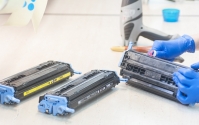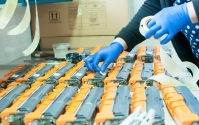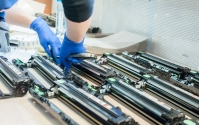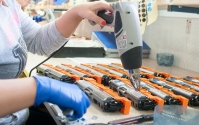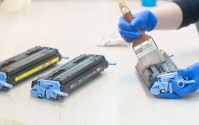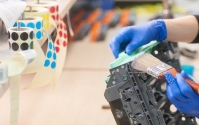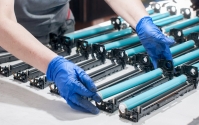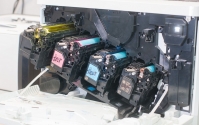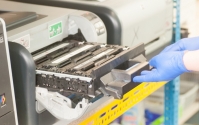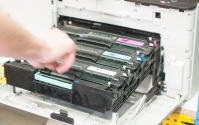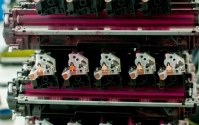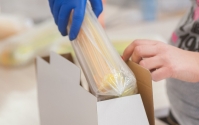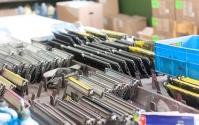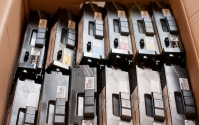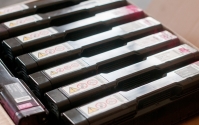Production
During the production process we use the best quality components that never break the patent laws.
We guarantee high quality of our products, 100% of products are subject to quality control.
The company has a quality management system that complies with EN ISO9001, cassettes are tested according to ISO / IEC 19752 and ISO / IEC 19798. The quality of introducing new toner models is guaranteed by our own research and development laboratory.
Construction of a laser printer cartridge
Each toner cartridge for a laser printer is a complex device containing several hundred parts.
The main elements are: Printing process
The photoconductive drum is electrostatically charged by the charging electrode, then illuminated by a laser that changes the electrostatic charge. The toner is taken by a magnetic roller and adheres to the photosensitive drum in the areas exposed by the laser beam creating an electrostatic image on the photosensitive drum.
Further rotation of the drum makes contact of the electrostatic picture with the paper, the discharge electrode allows the toner to fall from the photosensitive drum onto the paper. In the next step, the cleaning strip (wiper blade) transfers the remaining toner to the waste bin.Fixing the toner on the paper occurs in the thermal process, after passing the sheet through the heat roller and pressure roller. The cycle is repeated several times allowing print the page.
Regeneration process
It involves the replacement of used mechanical parts with new ones to enable the proper operation of all the mechanisms. Another process is to clean the waste toner box (waste bin) that is collected by the strip (wiper blade).
Then the toner cartridge is filled by high-quality dedicated toner powder. The chip counting the number of copies is also changed made to allow reset the counter to "0".
An important element is also the control of the gap between the doctor blade and the magnetic drum. It is realized by positioning the slat. These steps are designed to ensure even distribution of the proper amount of toner on the photosensitive drum of the regenerated cartridge.
The next stage of regeneration is quality control, (100% of the products), cassettes are tested according to the ISO / IEC 19752 and ISO / IEC 19798 standards.
Recycled cartridges are secured for transport by foil, air bags and paper boxes.
The management system complies with EN ISO9001, ensures high and repeatable quality of the regeneration process, and the same high quality of products.
It should be emphasized that JJK Toner uses environmentally friendly technologies in the production process.
It is also noteworthy that the process of regeneration is a recycling process introduced earlier into the market of devices, which contributes to the protection of the environment, which is a common good for all of us.
We guarantee high quality of our products, 100% of products are subject to quality control.
The company has a quality management system that complies with EN ISO9001, cassettes are tested according to ISO / IEC 19752 and ISO / IEC 19798. The quality of introducing new toner models is guaranteed by our own research and development laboratory.
Construction of a laser printer cartridge
Each toner cartridge for a laser printer is a complex device containing several hundred parts.
The main elements are:
- OPC (Organic Photo Conductor Drum), which is made on the basis of an aluminum tube covered with several layers forming a semiconductor.
- toner tank / toner - substance consisting of elements transmitting electrostatic charges and which blacken paper. It must be in accordance with the specifications provided by the manufacturer of this type of laser printer.
- developer roller (mag roller) takes the toner out of the tank and gives it a proper static charge, making the toner adhere in places which have been electrostatic charged by laser.
- doctor blade - is responsible for evenly distributing the correct amount of toner on the photosensitive drum.
- heating roller and pressure roller - fix and consolidate the toner powder with the medium (paper, cardboard, foil).
- wiper blade - removes residual toner from the photosensitive drum, which is stored in the waste bin.
- laser - irradiates the surface of the photosensitive drum, is controlled by the microprocessor of the printer.
- chip - electronic system counting the number of prints made.
The photoconductive drum is electrostatically charged by the charging electrode, then illuminated by a laser that changes the electrostatic charge. The toner is taken by a magnetic roller and adheres to the photosensitive drum in the areas exposed by the laser beam creating an electrostatic image on the photosensitive drum.
Further rotation of the drum makes contact of the electrostatic picture with the paper, the discharge electrode allows the toner to fall from the photosensitive drum onto the paper. In the next step, the cleaning strip (wiper blade) transfers the remaining toner to the waste bin.Fixing the toner on the paper occurs in the thermal process, after passing the sheet through the heat roller and pressure roller. The cycle is repeated several times allowing print the page.
It involves the replacement of used mechanical parts with new ones to enable the proper operation of all the mechanisms. Another process is to clean the waste toner box (waste bin) that is collected by the strip (wiper blade).
Then the toner cartridge is filled by high-quality dedicated toner powder. The chip counting the number of copies is also changed made to allow reset the counter to "0".
An important element is also the control of the gap between the doctor blade and the magnetic drum. It is realized by positioning the slat. These steps are designed to ensure even distribution of the proper amount of toner on the photosensitive drum of the regenerated cartridge.
The next stage of regeneration is quality control, (100% of the products), cassettes are tested according to the ISO / IEC 19752 and ISO / IEC 19798 standards.
Recycled cartridges are secured for transport by foil, air bags and paper boxes.
The management system complies with EN ISO9001, ensures high and repeatable quality of the regeneration process, and the same high quality of products.
It should be emphasized that JJK Toner uses environmentally friendly technologies in the production process.
It is also noteworthy that the process of regeneration is a recycling process introduced earlier into the market of devices, which contributes to the protection of the environment, which is a common good for all of us.
